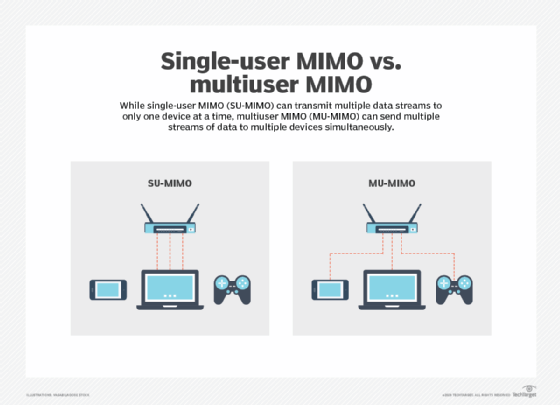
Tierney - stock.adobe.com
What's the difference between OFDMA vs. MU-MIMO in Wi-Fi 6?
Is there a difference between OFDMA and MU-MIMO? The two important Wi-Fi 6 features are complementary but distinct. Here's why.
The newest Wi-Fi 6 standard, also known as 802.11ax, relies on two key features to connect users more efficiently: OFDMA and MU-MIMO.
Multiuser multiple input, multiple output isn't a new wireless networking feature -- it was part of the Wi-Fi 5 Wave 2 standard -- but its capabilities are significantly greater in Wi-Fi 6. Orthogonal frequency-division multiple access made its 802.11 debut with the Wi-Fi 6 standard, although it has previously been used in LTE networks.
OFDMA is a technically complex feature that represents a significant achievement in wireless networking technology, and it has certainly generated its share of industry buzz. Both OFDMA and MU-MIMO are important in enabling more efficient connectivity, however. When it comes to OFDMA vs. MU-MIMO, the complementary features have some key differences.
OFDMA vs. MU-MIMO
MU-MIMO. Downlink MU-MIMO enables a wireless access point (AP) to divide its bandwidth into separate channels and broadcast to multiple clients at once. Wi-Fi 5 Wave 2's MU-MIMO feature supported up to four spatial streams, meaning an AP could communicate with up to four clients at a time via separate antennas. Wi-Fi 6 boosts that number to eight. It's important to note, however, that this capability currently works only in the downstream direction -- in AP-to-client communications. Uplink MIMO -- client-to-AP -- is still single-user, although that is expected to change in the second wave of the Wi-Fi 6 standard.

OFDMA. If MU-MIMO essentially adds more traffic lanes to the wireless highway that exists between AP and clients, OFDMA is like next-level carpooling. It flexibly subdivides each available channel into smaller subcarriers or resource units, which the AP can then dynamically assign across dozens of devices. This enables a degree of multitasking that exponentially increases efficiency, reducing network overhead, making better use of available bandwidth and dramatically increasing capacity. OFDMA is particularly relevant in high-density environments, like entertainment venues, as well as networks with many small-packet transmissions, such as those from IoT devices.
"It's able to take the dead spots in transmission and use them to communicate with other devices," said Zeus Kerravala, founder and principal analyst of ZK Research in Westminster, Mass. "That extra efficiency can then mean better battery life and many other benefits."







